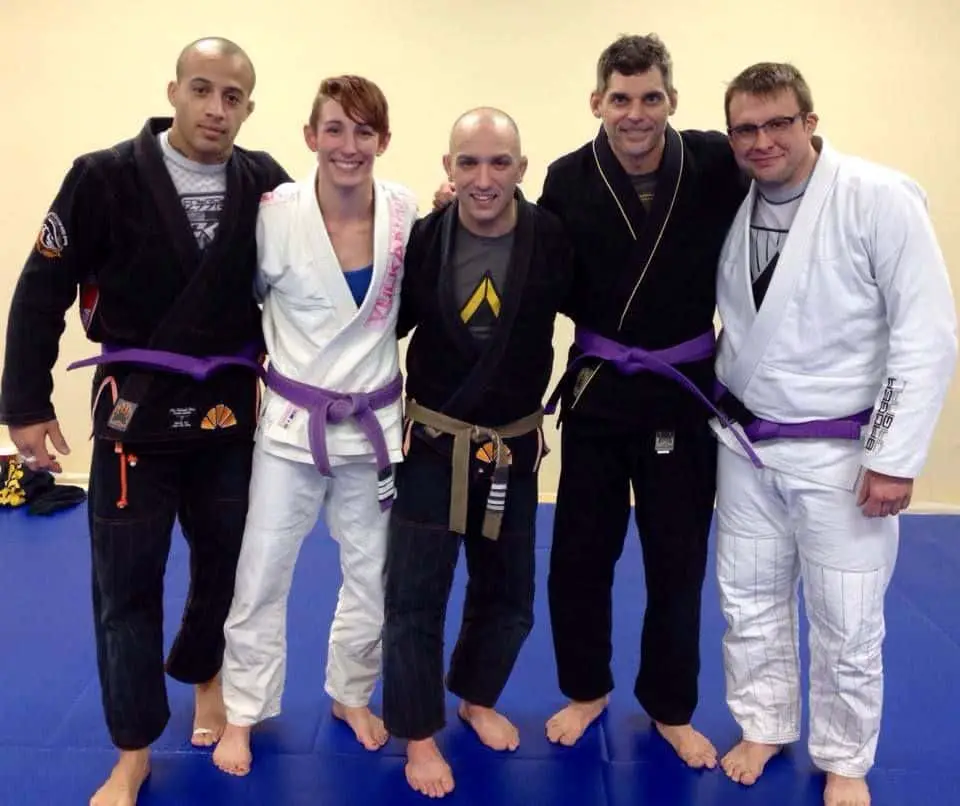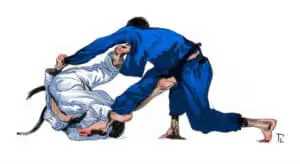
If you have just begun diving into BJJ or have a casual interest in the sport you would know the Brazilian martial art utilises a belt ranking system. The belts used in Jiu Jitsu are white, blue, purple, brown and black. Each belt symbolises a particular skill level. It is time to explore all things purple belt.
How Long Does It Take To Get A Purple Belt In BJJ?
To earn a purple belt in BJJ it takes on average 4 to 6 years of consistent training. To get your purple belt you have to spend between 1000 to 1500 hours training BJJ. This equates to averaging three 1.5 hour sessions a week for at least 4 years.
Receiving a purple belt in BJJ is not an easy feat. It requires a serious dedication to the martial art. If you are not willing to invest at least 1000 hours in training BJJ then your dreams of becoming a purple belt are likely to go unrealized.
This 1000 hours of training takes most BJJ athletes 4 to 6 years to achieve. Some truly dedicated/addicted practitioners are able to receive their purple belts in less time if they come from a high level wrestling or Judo background or they simply live on the mats and train 5 + days a week.
For example if you are a BJJ mat rat and you train 6 days a week with each session lasting 1.5 hours you could hit 1000 hours of training time in a little over 2 years. However, even if you do hit the 1000 hours and have the skill of a purple belt your coach may hold you back and not promote you.
Why Does It Take So Long To Get A Purple Belt In BJJ?
It takes so long to get a purple belt in BJJ because the belt symbolises the holder is a lower advanced practitioner. BJJ is a complex sport with thousands of techniques so achieving an advanced skill level takes time and dedication, typically at least 4 years of consistent training.

BJJ is not a martial art that comes naturally to people. On practitioners’ first day many will struggle to perform the simple warm up and then will look completely lost when trying to practice the basic techniques on a compliant training partner. Then when it comes to sparring you can forget about them doing anything that resembles Jiu Jitsu.
It is not an easy task taking a BJJ student with no grappling ability and turning them into a purple belt. This process literally takes years and years and athletes face many ups and downs including injuries and questioning if they will ever improve.
The process has to be long because of the amount of positions and techniques a BJJ practitioner has to learn and excel in before they are ready to earn a purple belt.
BJJ has thousands of techniques and many of these involve significant amounts of coordination which make it hard for students to grasp. You combine this with that positions such as guard are very unnatural for people. You can start to see why it takes so long for a new student to get good at BJJ and get promoted to purple belt.
What Does It Mean To Be A Purple Belt In BJJ?
A purple belt in BJJ means the student is an upper intermediate, lower advanced practitioner. They have strong fundamentals, are comfortable in the most common BJJ positions and are capable of teaching new students the basics of the art.

A purple belt should be good at BJJ. Purple belts should have no problem dominating any white belt with ease. If a purple belt can’t submit a white belt multiple times a round without breaking a sweat then they aren’t a purple belt.
By the time you get your purple belt you should be a force to be reckoned with on the mats. You should have a strong guard and the passing skills to match.
You will be able to submit your opponents with a variety of submissions. What submission is your go to depends on your personal preference but all purple belts will have strong arm bars and rear naked chokes.
While purple belts are strong Jiu Jitsu practitioners they are still not truly advanced martial artists yet. To fully reach mastery a purple belt will have to advance to brown and belt.
What separates a purple belt from a brown belt is overall knowledge. A brown belt will have a more in depth knowledge of BJJ. They will know more techniques and understand how to navigate positions more effectively. This is to be expected as the average brown belt will have 3 to 4 years more training than the typical purple belt.
Brown belts will also have a specialised game. Purple belts are usually still all rounders who are learning and trying out all different types of techniques and positions. While brown belts start focusing on their strengths, playing specific games and really taking a deep dive into their favoured techniques.
Brown belts are focused on learning much more about a few techniques while purple belts are still expanding their overall knowledge on many techniques.
How To Get A Purple Belt In BJJ Fast?
To get a purple belt in BJJ fast you can increase your training volume so you hit the required training hours quickly. On average you can get a purple belt after 1000 hours of training, this can be achieved by training 6 days a week, 1.5 hour a session for 2 years.

There is no time limit or required number of training hours to receive a purple belt. However, it takes most BJJ practitioners 4 to 6 years of consistent training while averaging 3 weekly sessions, each lasting 1.5 hours. This equals 1000 to 1500 hours of mat time. Even if you are terrible at BJJ your chance of receiving a purple belt is very high if you train for 1500 hours.
To get your purple belt quickly you need to hit at least 1000 hours of mat time in as little time as possible. This may seem like a lot of training and that it will take years to achieve but when you breakdown the math you can see you can easily shave years off your belt progression through sticking to a disciplined training schedule.
If you train 6 days a week for 1.5 hours each training session then in 2 years you will hit 1000 hours of mat time and you will likely be a purple belt. To ensure you receive your purple belt fast you can train 12 hours a week for 2.5 years and you will total 1500 hours on the mat.
With this amount of training your coach will be forced to promote you as you will be destroying the other blue belts at your team and terrorising a lot of purple belts as well.
The other option you have to getting a BJJ purple belt in rapid time is to come from an advanced grappling background, ideally wrestling, Judo or Sambo.

If you are an experienced Judo black belt, a college wrestler or a Sambo champion you can quickly earn a purple belt.
Travis Stevens, Olympic Judo Silver medalist was awarded a black belt from John Danaher after just 2 years of training BJJ.
Even an average Judo black belt should already be at a blue belt level of BJJ so with 1 to 2 years of extra training they should be able to receive a purple belt.
Wrestling does not translate to BJJ as well as Judo but still many of the movements are similar. There is no reason that an advanced wrestler who has competed for 6 + years can not receive a purple belt in under 2 years if they consistently train Jiu Jitsu.
